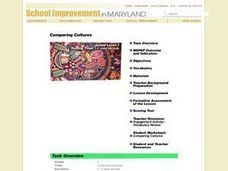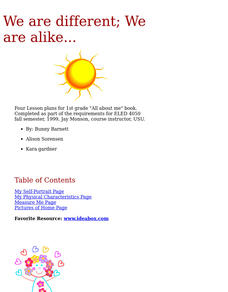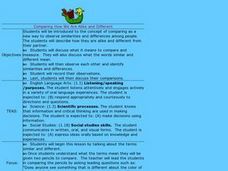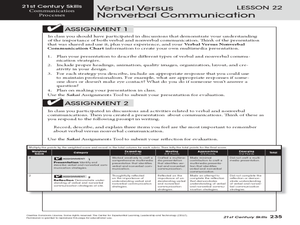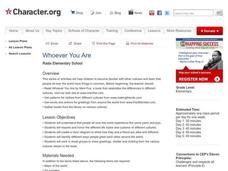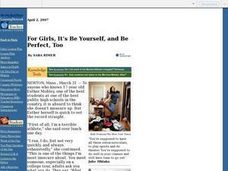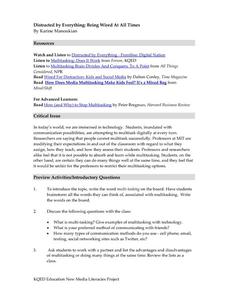Curated OER
Where Is Japan? How Are We Alike And Different?
First graders use literature, maps, and globes to explain how physical environments in various parts of the world are similar to and different from one's own, and that certain areas have common characteristics and can be called regions.
Curated OER
Comparing Cultures
Young readers compare two stories/cultures, identifying how they are alike and different. They share their own version of a well-known story and adapt it to another culture. They explain their adaptations.
Curated OER
We Are Different; We Are Alike........
First graders explain that everybody is unique in their own way by participating in this lively, art and language based series of lesson plans. They would greatly benefit from engaging in these plans in the beginning of the year as an...
Curated OER
Comparing How We Are Alike and Different
Students introduced to comparing as a way to observe differences among people.
Curated OER
We Are All Different in Many Ways!
Pupils discuss differences such as skin color, eye color, hair color, emotions, families, etc., to reinforce that it is okay to be different.
Curated OER
French and Family
Where is France? Interest young learners in exploring France, French language, and French culture. They identify similarities and differences between French and American families, speak the French words for family members, analyze maps,...
Curated OER
Understanding and Fighting Stereotypes through Words and Images
Use some provocative modern art to get your class considering stereotypes and the impact they have on us all. Your class will discuss the print art Indian Look-Alike by Melanie Yazzie and stereotypes in general before...
Curated OER
Verbal Versus Nonverbal Communication
Young scholars create a multimedia presentation. They will complete a verbal versus non-verbal communication chart to create a multimedia presentation which will include the different types of communication strategies. Then answer a...
Curated OER
Getting to Know You
Students converse with each other while playing a game in order to discover things that are alike and things that are different about themselves. The students gather data about themselves, organize and display data on the graph, and...
Peace Corps
Defining Culture
How has culture shaped you? Middle and high schoolers examine different aspects of one's culture, including religious beliefs, social customs, and family traditions, and discuss the ways that their personalities have been formed by these...
Curated OER
Whoever You Are
Students examine cultures, traditions, and feeling throughout cultures. For this cultural lesson, students use literature, maps, and cultural information to examine how people have universal feelings despite their different cultures and...
Seterra
Northern Europe: Countries - Map Quiz Game
Remembering geography is a tiring and tedious task to many scholars. Change it up by assigning the map quiz game. Elementary and middle schoolers alike test their knowledge and compete with the clock to match as many countries as...
Denver Art Museum
Putting Images into Words
Engage your class in art analysis of Indian Look-Alike by Melanie Yazzie. Using this work of art as inspiration, writers compose a poem or short story. After a peer review session, the teacher conveys information about the work of art as...
Curated OER
Working' (More Than) 9 to 5
Students consider how men and women are alike and different, and explore society's expectations of how members of each gender should balance work and family life by taking surveys.
Curated OER
Discrimination on the Menu
Students study discrimination in the workplace. In this discrimination lesson, students define the term 'fair' and work in groups to find ways all people are alike and different. Students write sentences defining a fair classroom, a fair...
Curated OER
Recognizing Our Similarities and Differences: King Day
Students discover diversity. In this service learning lesson plan, students read The Sneeches and discuss the benefits of being respectful toward one another.
Curated OER
China: Venn
In this history worksheet, students utilize a Venn Diagram to compare China with another country. Students draw three circles and put things that are alike in one, things about China in one and things about the other country in the third...
Curated OER
BRIDGING THE GENERATION GAP
Students create a hypothesis about the attitudinal differences between generations, test their hypothesis with a survey, chart their findings, and present their answers to the class.
Curated OER
Simon Says "Who Are You?"
Students explore their similarities and differences. In this getting to know you instructional activity, students play a variation of "Simon Says," according to various personality and physical traits.
Curated OER
We Are Alike, We Are Different:A Focus on Japan
First graders develop a connection with students in a first grade classroom in Japan. They begin to develop a curiosity about Japan--the landscape, the people, and their culture, while developing an understanding of the Five Themes of...
National Endowment for the Humanities
La Familia
Young scholars identify at least one country where the Spanish language is spoken, describe similarities and differences between Spanish, Mexican, and Puerto Rican families, and practice speaking the Spanish words for several family...
NPR
Distracted by Everything - Being Wired at All Times
This multimedia activity challenges media-savvy learners to look at the critical issue concerning the inundation of technology and multitasking in the classroom, and its effects on the education of themselves and others. The tasks...
Learning for Life
Race, Religion, and Culture
Accepting others as individuals regardless of differences in appearances, languages, and interests is an important life skill for youngsters to acquire. The activities provided in this resource will support learners as they explore the...
Curated OER
Does It Look All Right to Me?
Learners identify different viewpoints in society. They describe the characteristics of some of the individuals involved in the march from Selma to Montgomery, Alabama. They listen to a historical narrative and identify issues of...



